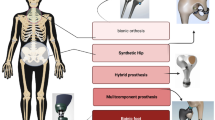Abstract
Modular neck implants are an attractive treatment tool in total hip replacement. Concerns remain about the mechanical stability and metal ion release caused by the modular connection. Five different implant designs were investigated in an experimental set-up. In vivo conditions were simulated and the long-term titanium release was measured. Finally, the modular connections were inspected for corrosion processes and signs of fretting. No mechanical failure or excessive corrosion could be identified for the implants tested. The titanium releases measured were extremely low compared to in vivo and in vitro studies and were not in a critical range.
Résumé
Dans les prothèses totales de hanche l’utilisation d’implants avec col modulaire est d’une utilisation fréquente et pratique. Néanmoins, cette utilisation laisse persister des doutes sur la stabilité mécanique et sur le relargage des ions métalliques. 5 différents implants ont été étudiés en reproduisant les conditions in vivo, en mesurant le relargage de titane et en évaluant la corrosion et les lésions du col. Ce travail n’a pas permis de mettre en évidence d’échec secondaire à une corrosion excessive, et les taux de titane sont restés extrêmement bas dans les limites de l’acceptable.




Similar content being viewed by others
References
Aldinger PR, Thomsen M, Mau H, Ewerbeck V, Breusch SJ (2003) Cementless Spotorno tapered titanium stems: excellent 10–15-year survival in 141 young patients. Acta Orthop Scand 74:253–258
Bachnick M, Hasenpusch M, Richter H, Boenick U (1994) Effect of hardness and surface quality of metal cones on fracture load of ceramic ball heads of hip endoprostheses (in German). Biomed Tech (Berl) 39:302–306
Bergmann G, Deuretzbacher G, Heller M, Graichen F, Rohlmann A, Strauss J, Duda GN (2001) Hip contact forces and gait patterns from routine activities. J Biomech 34:859–871
Bobyn JD, Tanzer M, Krygier JJ, Dujovne AR, Brooks CE (1994) Concerns with modularity in total hip arthroplasty. Clin Orthop Relat Res 298:27–36
Coen N, Kadhim MA, Wright EG, Case CP, Mothersill CE (2003) Particulate debris from a titanium metal prosthesis induces genomic instability in primary human fibroblast cells. Br J Cancer 88:548–552
Daley B, Doherty AT, Fairman B, Case CP (2004) Wear debris from hip or knee replacements causes chromosomal damage in human cells in tissue culture. J Bone Joint Surg Br 86:598–606
Gilbert JL, Buckley CA, Jacobs JJ (1993) In vivo corrosion of modular hip prosthesis components in mixed and similar metal combinations. The effect of crevice, stress, motion, and alloy coupling. J Biomed Mater Res 27:1533–1544
Goldberg JR, Gilbert JL, Jacobs JJ, Bauer TW, Paprosky W, Leurgans S (2002) A multicenter retrieval study of the taper interfaces of modular hip prostheses. Clin Orthop Relat Res 401:149–161
Hallab NJ, Messina C, Skipor A, Jacobs JJ (2004) Differences in the fretting corrosion of metal-metal and ceramic-metal modular junctions of total hip replacements. J Orthop Res 22:250–259
Heisel C, Streich N, Krachler M, Jakubowitz E, Kretzer JP (2008) Characterization of the running-in period in total hip resurfacing arthroplasty: an in vivo and in vitro metal ion analysis. J Bone Joint Surg Am 90(Suppl 3):125–133
Hol PJ, Molster A, Gjerdet NR (2008) Should the galvanic combination of titanium and stainless steel surgical implants be avoided? Injury 39:161–169
Jacobs JJ, Urban RM, Gilbert JL, Skipor AK, Black J, Jasty M, Galante JO (1995) Local and distant products from modularity. Clin Orthop Relat Res 319:94–105
Kawalec JS, Brown SA, Payer JH, Merritt K (1995) Mixed-metal fretting corrosion of Ti6Al4V and wrought cobalt alloy. J Biomed Mater Res 29:867–873
Khan MA, Williams RL, Williams DF (1999) The corrosion behaviour of Ti-6Al-4V, Ti-6Al-7Nb and Ti-13Nb-13Zr in protein solutions. Biomaterials 20:631–637
Lewis G (2004) Geometric element analysis of fretting in a model of a modular femoral component of a hip implant. Biomed Mater Eng 14:43–51
Mroczkowski ML, Hertzler JS, Humphrey SM, Johnson T, Blanchard CR (2006) Effect of impact assembly on the fretting corrosion of modular hip tapers. J Orthop Res 24:271–279
Piozzi R, Ribeiro DA, Padovan LE, Filho HN, Matsumoto MA (2009) Genotoxicity and cytotoxicity in multiple organs induced by titanium miniplates in Wistar rats. J Biomed Mater Res A 88:342–347
Rogers SD, Howie DW, Graves SE, Pearcy MJ, Haynes DR (1997) In vitro human monocyte response to wear particles of titanium alloy containing vanadium or niobium. J Bone Joint Surg Br 79:311–315
Schwab LP, Xing Z, Hasty KA, Smith RA (2006) Titanium particles and surface-bound LPS activate different pathways in IC-21 macrophages. J Biomed Mater Res B Appl Biomater 79:66–73
Shareef N, Levine D (1996) Effect of manufacturing tolerances on the micromotion at the Morse taper interface in modular hip implants using the finite element technique. Biomaterials 17:623–630
Urban RM, Jacobs JJ, Gilbert JL, Galante JO (1994) Migration of corrosion products from modular hip prostheses. Particle microanalysis and histopathological findings. J Bone Joint Surg Am 76:1345–1359
Viceconti M, Baleani M, Squarzoni S, Toni A (1997) Fretting wear in a modular neck hip prosthesis. J Biomed Mater Res 35:207–216
Viceconti M, Ruggeri O, Toni A, Giunti A (1996) Design-related fretting wear in modular neck hip prosthesis. J Biomed Mater Res 30:181–186
Virtanen S, Milosev I, Gomez-Barrena E, Trebse R, Salo J, Konttinen YT (2008) Special modes of corrosion under physiological and simulated physiological conditions. Acta Biomater 4:468–476
Warashina H, Sakano S, Kitamura S, Yamauchi KI, Yamaguchi J, Ishiguro N, Hasegawa Y (2003) Biological reaction to alumina, zirconia, titanium and polyethylene particles implanted onto murine calvaria. Biomaterials 24:3655–3661
Acknowledgments
The authors thank the Ministry of Arts and Science of Baden-Württemberg (Germany) for supporting this work with research grants and Tom Bruckner (Ph.D.) from the Institute of Biometrics of the University of Heidelberg for expert advice on statistics.
Author information
Authors and Affiliations
Corresponding author
Rights and permissions
About this article
Cite this article
Kretzer, J.P., Jakubowitz, E., Krachler, M. et al. Metal release and corrosion effects of modular neck total hip arthroplasty. International Orthopaedics (SICOT) 33, 1531–1536 (2009). https://doi.org/10.1007/s00264-009-0729-x
Received:
Accepted:
Published:
Issue Date:
DOI: https://doi.org/10.1007/s00264-009-0729-x




